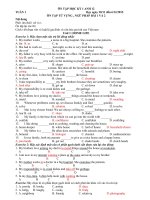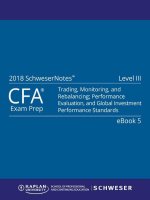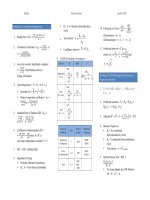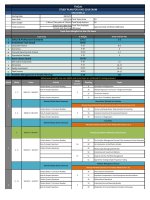Examinable documement 2018
Bạn đang xem bản rút gọn của tài liệu. Xem và tải ngay bản đầy đủ của tài liệu tại đây (70.42 KB, 6 trang )
Examinable Documents
September 2018 to June
2019
FINANCIAL REPORTING
The examinable documents below are applicable to
the International and UK papers as indicated at the
start of each table.
Knowledge of new examinable regulations issued by
1 September will be required in examination
sessions being held in the following exam year.
Documents may be examinable even if the effective
date is in the future.
The documents listed as being examinable are the
latest that were issued by 1 September 2017 and
will be examinable in September 2018, December
2018, March 2019 and June 2019 examination
sessions.
The study guide offers more detailed guidance on
the depth and level at which the examinable
documents will be examined. The study guide
should be read in conjunction with the examinable
documents list.
Title
IAS 1
IAS 2
IAS 7
IAS 8
IAS 10
IAS 12
IAS 16
IAS 19
IAS 20
IAS 21
IAS 23
IAS 24
IAS 27
IAS 28
IAS 32
IAS 33
IAS 34
IAS 36
IAS 37
IAS 38
IAS 40
IAS 41
IFRS 1
IFRS 2
IFRS 3
International Accounting Standards (IASs)/International
Financial Reporting Standards (IFRSs)
Presentation of Financial Statements
Inventories
Statement of Cash Flows
Accounting Policies, Changes in Accounting Estimates and
Errors
Events after the Reporting Period
Income Taxes
Property, Plant and Equipment
Employee Benefits
Accounting for Government Grants and Disclosure of
Government Assistance
The Effects of Changes in Foreign Exchange Rates
Borrowing Costs
Related Party Disclosures
Separate Financial Statements
Investments in Associates and Joint Ventures
Financial Instruments: Presentation
Earnings per Share
Interim Financial Reporting
Impairment of Assets
Provisions, Contingent Liabilities and Contingent Assets
Intangible Assets
Investment Property
Agriculture
First-time Adoption of International Financial Reporting
Standards
Share-based Payment
Business Combinations
FR
SBR
INT
and
UK
1
IFRS 5
IFRS 7
IFRS 8
IFRS 9
IFRS 10
IFRS 11
IFRS 12
IFRS 13
IFRS 15
IFRS 16
IFRS for SMEs
Practice Stmt
ED/2016/1
ED/2015/8
ED 2015/3
2
Non-Current Assets Held for Sale and Discontinued Operations
Financial Instruments: Disclosures
Operating Segments
Financial Instruments
Consolidated Financial Statements
Joint Arrangements
Disclosure of interests in Other Entities
Fair Value Measurement
Revenue from Contracts with Customers
Leases
IFRS for Small and Medium Sized Entities
Other Statements
The Conceptual Framework for Financial Reporting
Management Commentary
The International <IR> Framework
EDs, Discussion Papers and Other Documents
Definition of a Business and Accounting for Previously Held
Interests
IFRS Practice Statement Application of Materiality to Financial
Statements
Conceptual Framework for Financial Reporting
ADDITIONALLY EXAMINABLE FOR SBR UK and IRISH PAPERS ONLY
Indicated below are the main areas of difference between full IFRS and some chapters of UK FRS 102 that are
examinable in SBR.
FRS 102 Chapter
Full IFRS equivalent
1
Scope
Preface to International
Financial Reporting Standards
(IFRS)
2
Concepts and
principles
Financial
Statement
Presentation
Statement of
Financial
Position
IASB Conceptual Framework
and IFRS 13
IASB Conceptual Framework
and IAS 1 Presentation of
Financial Statements
IASB Conceptual Framework
and IAS 1 Presentation of
Financial Statements
IASB Conceptual Framework
and IAS 1 Presentation of
Financial Statements
3
4
5
7
Statement of
Comprehensiv
e Income and
Income
statement
Statement of
Cash Flows
IAS 7 Statement of cash flows
Where FRS 102 requirements differ from full
IFRS
FRS 100 Application of Financial Reporting
Requirements sets out the scope of FRS 102 and
establishes which accounting frameworks should be
used by different entities under the UK regulatory
framework.
FRS 102 uses only two measurement basis of HC
and FV
Companies Act requirements in relation to the true
and fair override
Companies Act requirements
Companies Act requirements
Under FRS 102, a qualifying entity may elect not to
include a statement of cash flows in its individual
financial statements.
The definition of control differs in FRS 102. There
are also differences where a subsidiary is held for
resale. When an entity is a parent and prepares
separate financial statements, FRS 102 adopts
differences in approach. FRS 102 includes an
exclusion of a subsidiary from consolidation on the
grounds of severe long-term restrictions.
9
Consolidated
and Separate
Financial
Statements
IAS 27 Separate Financial
Statements
IFRS10 Consolidated
Financial Statements
IFRS 12 Disclosure of
Interests in Other Entities
10
Accounting
Policies,
Estimates and
Errors
Basic and
other financial
instruments
IAS 8 Accounting Policies,
Changes in Accounting
Estimates and Errors
FRS 102 states that a change to the cost model
when a reliable measure of fair value is not
available is not a change in accounting policy.
IFRS 9 Financial Instruments
13
Inventories
IAS 2 Inventories
FRS 102 divides financial instruments into basic and
other. The former are normally valued at amortised
cost and the latter at fair value through profit or loss.
Unlike FRS 102, IFRS 9 adopts an ‘expected loss’
model rather than an ‘incurred loss’ model. FRS 102
establishes a simplified model for the de-recognition
of financial assets.
FRS102 provides additional guidance on what
should be included in production overheads.
FRS 102 Impairment losses can be reversed.
14
Investments in
Associates
IAS 28 Investments in
Associates and Joint Ventures
15
Investments in
IFRS 11 Joint Arrangements
11&12
Differences between IFRS and FRS 102 may arise
because of the different requirements for acquisition
accounting.
FRS 102 classifies joint ventures differently than
IFRS.
3
16
4
joint ventures
Investment
property
IAS 40 Investment Property
17
Property, plant
and equipment
IAS 16 Property, Plant and
Equipment
IFRS 5 Non-current Assets
Held for Sale and
Discontinued Operations
18
Intangible
assets other
than goodwill
IAS38 Intangible Assets
19
Business
Combinations
and Goodwill
IFRS 3 Business
Combinations
20
Leases
IFRS 16 Leases
21
Provisions and
Contingencies
IAS 37 Provisions, Contingent
Liabilities and Contingent
Assets
After initial recognition, FRS 102 does not offer the
cost model as an immediately available option. FRS
102 does not cover the situation where the lessor
provides ancillary services to the occupants of a
property.
There is no separate guidance in FRS 102 for noncurrent assets held for sale. Under FRS 102 there is
an accounting policy choice as to whether to
capitalise directly attributable borrowing costs on
qualifying assets. Under FRS 102, a review of
residual value and useful life is only required when
indicators of change are present. FRS 102 does not
address assets held for sale; the decision to sell an
asset is considered an impairment indicator
although continuing and discontinued activities must
be analysed.
Under FRS 102, an entity may recognise an
intangible asset arising from development if certain
criteria are met. An intangible asset acquired in a
business combination can be treated differently in
accordance with FRS 102. FRS 102 states that if an
intangible asset is acquired free of charge or for
nominal consideration by way of a grant, the cost of
that intangible asset is its fair value at the date the
grant is received or receivable. In exceptional
cases, if an entity is unable to make a reliable
estimate of the useful life of an intangible asset,
FRS 102 states that the life should not exceed 10
years.
Under FRS 102, transaction costs are included in
the cost of acquisition. Contingent consideration is
also included as part of the acquisition cost if it is
probable that the amount will be paid and it can be
measured reliably. FRS 102 states that where
control is achieved through a series of transactions,
the acquisition cost is the total of the fair values of
the assets given, liabilities assumed and equity
instruments issued. FRS 102 requires negative
goodwill to be recognised in profit or loss in the
periods expected benefit from its existence. FRS
102 utilises only the proportionate share method for
NCI and not the fair value method. IFRS 3 includes
more detailed rules than FRS 102 on fair valuation.
FRS 102 treats leases as finance or operating
leases in the financial statements of the lessee.
Detailed accounting transactions for leases will not
be examined in the UK syllabus although high level
principles might be examined in a narrative
question.
FRS 102 provides limited guidance on accounting
for restructurings. This section in FRS 102 applies
to financial guarantee contracts.
23
Revenue
IFRS 15 Revenue from
Contracts with Customers
FRS 102 does not adopt the five step rule in IFRS
16. Detailed accounting transactions for revenue
will not be examined in the UK syllabus although
high level principles might be examined in a
narrative question.
24
Government
Grants
25
Borrowing
Costs
IAS 20 Accounting for
Government Grants and
Disclosure of Government
Assistance
IAS 23 Borrowing Costs
26
Share-based
payment
IFRS 2 Share-based Payment
27
Impairment of
assets
IAS 36 Impairment of Assets
28
Employee
Benefits
IAS 19 Employee Benefits
29
Income tax
IAS 12 Income Taxes
30
Foreign
Currency
Translation
IAS 21 The Effects of Change
in Foreign Exchange Rates
FRS 102 requires an entity to recognise grants
either based on the performance model or the
accrual Model. FRS 102 is silent on what happens if
a grant becomes repayable.
FRS 102 allows a choice of whether to capitalise
borrowing costs. FRS 102 gives specific guidance
on the capitalisation rate to be used.
FRS 102 requires an entity to measure the fair value
of shares and the related goods or services
received using a three-tier measurement hierarchy.
FRS 102 provides simplified guidance on share
based payments.
If there is no indication of impairment under FRS
102 and it is not necessary to estimate the
recoverable amount. FRS 102 is silent on many
areas where IAS 36 provides more detailed
guidance.
FRS 102 requires an entity to have a detailed formal
plan in place, with no realistic possibility of
withdrawal from the plan if a termination is linked to
a restructuring. Under FRS 102, when an employee
has rendered service during the reporting period,
the amounts recognised should be the undiscounted
amount of short-term employee benefits expected to
be paid in exchange for that service.
Under FRS 102, deferred tax is recognised based
on timing differences rather than temporary
differences. In addition, there are additional
recognition requirements for certain other
differences (a ‘timing differences plus’ approach).
FRS 102 does not require a foreign currency
translation reserve or permit or require recycling.
32
Events after
the end of the
Reporting
Period
Related Party
Disclosures
IAS 10 Events after the
Reporting Period
Under FRS 102, dividends declared after the end of
the reporting period may be presented as a
separate component of retained earnings.
IAS 24 Related Party
Disclosures
Specialised
Activities
IAS 41 Agriculture
FRS 102 provides a disclosure exemption for
transactions with wholly-owned subsidiaries and
parents within a group and a disclosure exemption
for compensation of key management personnel by
category and type of benefit.
FRS 102 states that, for each class of biological
asset and its related agricultural produce, an entity
has a choice of either the fair value or the cost
model.
33
34
Additionally for the SBR UK paper, the changes made to UK GAAP in 2015 are examinable including an
overview of FRS 105 The Financial Reporting Standard applicable to the Micro-entities Regime and the
following basic Companies Act requirements that address when:
5
6
single and group entity financial statements are required
exemptions may be claimed from the preparation
a subsidiary may be excluded from the group financial statements









